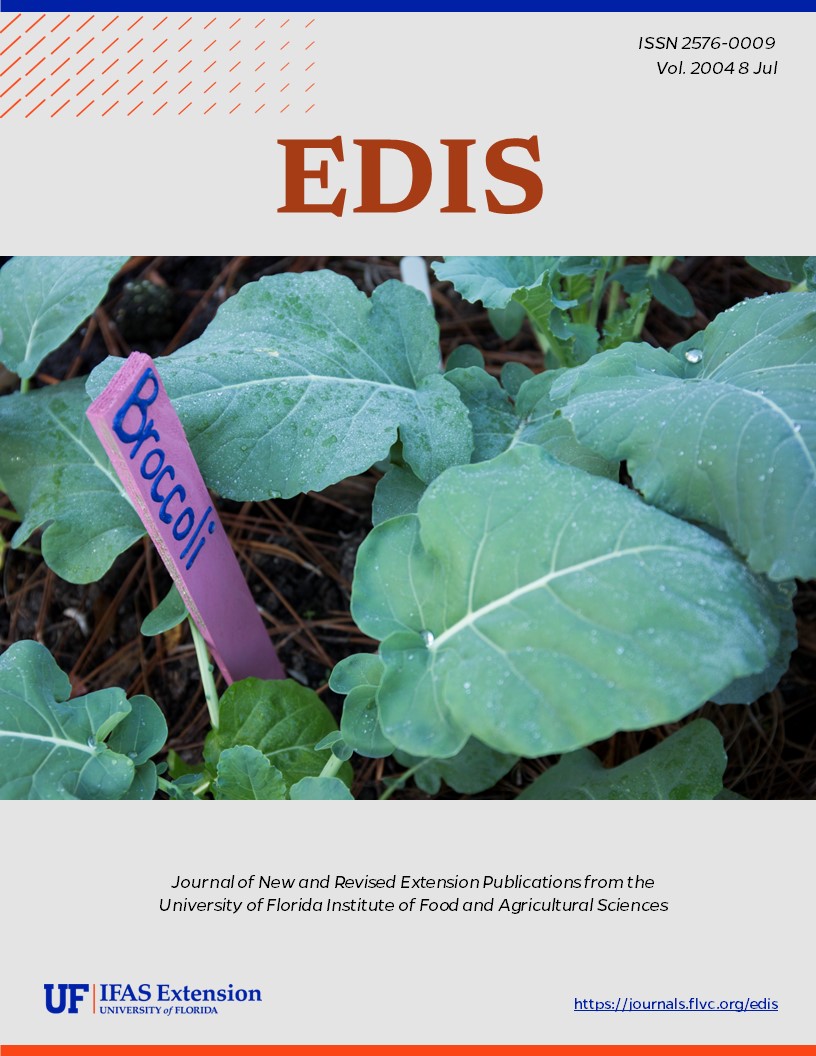Abstract
The Mediterranean fruit fly, Ceratitis capitata (Wiedemann), is one of the world's most destructive fruit pests. The species originated in sub-Saharan Africa and is not known to be established in the United States. When it has been detected in Florida and California, especially in recent years, each infestation necessitated intensive and massive eradication and detection procedures so that the pest did not become established. This document is EENY-214 (originally published as DPI Entomology Circulars 4, 230 and 273), one of a series of Featured Creatures from the Entomology and Nematology Department, Florida Cooperative Extension Service, Institute of Food and Agricultural Sciences, University of Florida. Published: July 2001. Revised: September 2001.
References
Ayers EL. 1957. The two medfly eradication programs in Florida. Proceedings of the Florida State Horticultural Society 70: 67-69.
Back EA, Pemberton CE. 1915. Life history of the Mediterranean fruit fly from the standpoint of parasite introduction. Journal of Agricultural Research 3: 363-374. United States Department of Agriculture, Washington, D.C.
Back EA, Pemberton CE. 1918. The Mediterranean fruit fly in Hawaii. United States Department of Agriculture Bulletin 536: 1-119. https://doi.org/10.5962/bhl.title.64531
Back EA, Pemberton CE. 1918. The Mediterranean fruit fly. United States Department of Agriculture Bulletin 640: 1-43. https://doi.org/10.5962/bhl.title.64531
Berg GH. 1979. Pictorial key to fruit fly larvae of the family Tephritidae. San Salvador: Organ. Internac. Region. Sanidad. Agropee. 36 p.
Christenson LD, Foote RH. 1960. Biology of fruit flies. Annual Review of Entomology 5: 171-192. https://doi.org/10.1146/annurev.en.05.010160.001131
Conley KL. 1981 (publication date not given). Field guide to medfly infestation. Cooperative Mediterranean Fruit Fly Project (California). 13 p.
De Woskin R. 1981. Medfly training manual. Joint cooperative Mediterranean fruit fly eradication project. United States Deptartment of Agriculture, California Department of Food and Agriculture, Santa Clara County Agriculture Commissioner, Alameda County Department of Agriculture 215 p.
Dixon WN, Hamon AB. (October 1998). Completed Medfly Programs in Florida, 1998. http://www.doacs.state.fl.us/pi/enpp/ento/miami-sp.html (22 June 2001).
Foote RH. 1967. Family Tephritidae. In Vanzolini, M., ed., A catalogue of the Diptera of the Americas south of the United States 57: 1-91. Dept. Zool., Sec. Agric., Sao Paulo, Brasil.
Fuller M, Fasulo TR. (1998). Mediterranean Fruit Fly Pest Alert Archives. http://extlab7.entnem.ufl.edu/PestAlert/Medfly/medfly.htm (15 June 2001).
Greene CT. 1929. Characters of the larvae and pupae of certain fruit flies. Journal of Agricultural Research 38: 489-504.
Hardy DE. 1949. Studies in Hawaiian fruit flies. Proceedings of the Entomology Society of Washington 51: 81- 205.
Heppner JB. 1984. Larvae of fruit flies. I. Anastrepha ludens (Mexican fruit fly) and Anastrepha suspensa (Caribbean fruit fly) (Diptera: Tephritidae). Florida Department of Agriculture and Consumer Services, Division of Plant Industry Entomology Circular 260: 1-4.
Knapp JL. (1981). The Mediterranean fruit fly. EDIS http://edis.ifas.ufl.edu/CH040 (15 June 2001).
Meyer CA. 1976. Mediterranean fruit fly impact in Central America. United States Department of Agriculture Cooperative Plant Pest Report 1: 117-118.
Mitchell WC, Andrew CO, Hagen KS, Hamilton RA, Harris EJ, Maehler KL, Rhode RH. 1977. The Mediterranean fruit fly and its economic impact on Central American countries and Panama. UC/AID Pest Management and Related Environmental Protection Project at the University of California, Berkeley. 189 p.
Moreno D. (September 2000). Field evaluation of a phototoxic dye, phloxine B, against three species of fruit flies (Diptera: Tephritidae). USDA ARS. http://nps.ars.usda.gov/publications/publications.htm?lognum=0000115809 (23 June 2001).
Phillips VT. 1946. The biology and identification of trypetid larvae (Diptera: Trypetidae). Memoirs of the American Entomological Society 12: 1-161.
Rhode RH, Simon J, Perdomo A, Gutierrez J, Dowling Jr. CF, Linquist DA. 1971. Application of the sterile-insect-release technique in Mediterranean fruit fly suppression. Journal of Economic Entomology 64: 708-713. https://doi.org/10.1093/jee/64.3.708
Stephenson DP. Mediterranean fruit fly not present in New Zealand. StephensonB@maf.govt.nz. (17 July 2001).
UF/IFAS. Anonymous. (1998). Impact of Meditrrranean fruit fly on dooryard fruits. University of Florida. http://entnemdept.ifas.ufl.edu/dooryard.htm (15 June 2001).
USDA. Anonymous. (June 2000). For males only: temperature-sensitive Medflies. Agricultural Research Magazine. United States Deptartment of Agriculture, Washington, D.C. http://www.ars.usda.gov/is/AR/archive/jun00/flies0600.htm (23 June 2001).
USDA. New Pest Detection and Survey Staff. 1975. Mediterranean fruit fly in the U.S. - 1975. Cooperative Economic Insect Report 25: 825-839. Plant Protection and Quarantine Programs, Animal and Plant Health Inspection Service, United States Department of Agriculture.
White IM, Elson-Harris MM. 1994. Fruit Flies of Economic Significance: Their Identification and Bionomics. CAB International. Oxon, UK. 601 p.
Unless otherwise specified, articles published in the EDIS journal after January 1, 2024 are licensed under a Creative Commons Attribution-NonCommercial-NoDerivs 4.0 International (CC BY-NC-ND 4.0) license.

